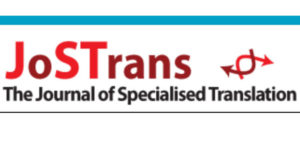[CFP] JoSTrans 35 (2021): Special Issue on ‘Translation and Plurisemiotic Practices’
 JoSTrans 35 (January 2021)
JoSTrans 35 (January 2021)
Special issue ‘Translation and Plurisemiotic Practices’
Guest editors: Francis Mus (Université de Liège – CIRTI) and Sarah Neelsen (Université Sorbonne Nouvelle – CEREG)
This special issue of JoSTrans is a contribution to the current research on translating ‘multidimensional’ works that combine texts with other semiotic elements such as music, lighting, body movements or images, usually associated with the stage. Translators who have to transfer those plurisemiotic works face hybrid objects: as meaning is not only invested in words, translators must thus take into account this intersemiotic dialectics and create multidimensional works as well.
Contributions may address the following plurisemotic pratices: theatre, performance, music, poetry in sign language, plastic arts.
Some plurisemiotic practices have already been the object of academic research. This particularly applies to translation for the stage and audiovisual translation, two fields of research that have remarkably developed over the past two decades. Other areas are much less explored. Research on the interweaving of translation and music is much more recent, especially when popular music is involved. This is also the case for translation and plastic arts, the interconnection of which has rarely been the object of systematic research: can the translation of a text be shaped as an art object? What kind of translation does the circulation of plastic works require? Sign language has attracted a lot of interest of late, but is mostly studied as a language of translation rather than as a language of creation.
The 35th issue of JoSTrans will carry on developments already started in several previous issues, for instance ‘The Translation of Multimodal Texts’ (2013) and ‘Translation in the Creative Industries’ (2018), though in this forthcoming 35th issue contributions will be limited to plurisemiotic practices performed in front of an audience. Communication between artist(s) and audience(s) occurs through some form of ‘translation’, ‘localization’ or ‘adaptation’. Analyses can thus also tackle new professional fields of expertise as well as the development of new translation technologies, various topics that have already been addressed in several issues, particularly in issues n°23 (2015), 26 (2016) and 30 (2018).
Contributions should be thematically and methodologically related to one of the following areas of research:
1. While indeed some practices have already been studied in other disciplines (literary studies, semiotics, cultural studies, etc.), the focus will be here on Translation Studies. Proposals should belong, both thematically and methodologically, to an epistemological tradition in Translation Studies that provides tools to identify the specific nature of translation, while keeping in mind its intrinsically interdisciplinary dimension. Indeed, since some semiotic devices (for instance, can or should a tune or an image be translated?) and their interaction (for instance the relationship between text and image or between text and music) are often valued differently in different cultures, all translation will necessarily, to some extent, also be a ‘cultural translation’.
2. We aim at bringing together articles that go beyond case studies and achieve a cohesive whole in which several artistic disciplines are addressed and general hypotheses examined. We will also raise the question whether there are challenges or translation techniques that apply to all artistic practices under scrutiny. Is it for instance possible to translate independently the various semiotic devices that concur in a work? How can translators ‘distribute’ (the translation of) those devices in the translation process itself? Should the ‘distribution’ in the target text be ‘equivalent’ to what it is in the source text? How can such an equivalence be defined? Can we talk here of a ‘compensation’ strategy? Finally, does the translation of plurisemiotic works bring up some exceptional feature in translators’ activity, or does the very complexity of these works provide an ideal research object to illustrate some fundamental principles in any translation activity?
3. In this respect the part played by translators is essential. Since their translation must simultaneously take into account several semiotic systems, sometimes at the very moment when the practice occurs on stage, their position is significantly changed / revalued. Indeed, the overlapping of technological developments over the second half of the twentieth century with the recognition and ever greater visibility of translators has extended the field in which the latter can perform their art. In Translation Studies too this new freedom has been recognized and studied since a prescriptive research tradition has yielded to descriptive approaches that do not only focus on equivalence, but are also interested in the translators’ creative role. In this respect the study of plurisemiotic works will make it possible to better define the limits and the possibilities of translators as co-authors and to shed light on all sorts of collaborations they can develop (with directors, musicians, actors, etc.). The reception of works which include some form of translation can also be examined, notably from the perspective of co-construction of meaning by audiences and translators.
Contributions can be written in French or English and must not be over 7,000 words (footnotes and bibliographies included).
Publication schedule:
- Proposals (500-word abstract + biographical notice) must be sent by 1 February 2019 to the two guest editors:
Francis Mus (francis.mus@uliege.be)
Sarah Neelsen (sarah.neelsen@sorbonne-nouvelle.fr)
Full articles must be sent by 25 August 2019.
The journal’s style sheet can be downloaded at www.jostrans.org/style.php
